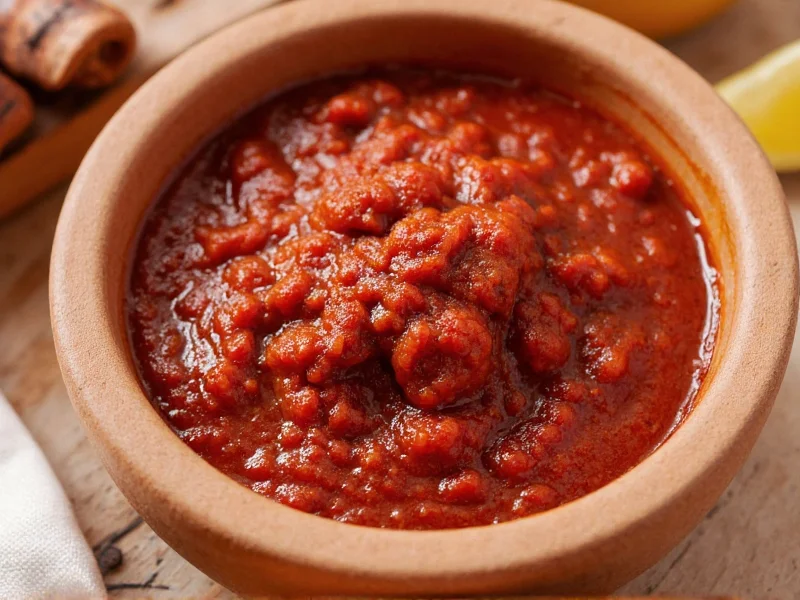Understanding how to use guajillo paste in recipes unlocks authentic Mexican cooking potential. Guajillo peppers (chiles guajillos) rank as Mexico's second-most popular dried chili after ancho peppers. When transformed into paste, they deliver consistent flavor and convenience compared to whole dried peppers.
Guajillo Paste Flavor Profile and Characteristics
Guajillo paste offers a distinctive taste profile that sets it apart from other chili pastes. Its flavor combines:
- Tangy red berry notes (reminiscent of cranberry or cherry)
- Subtle floral undertones
- Leathery, earthy depth
- Mild to medium heat level (significantly milder than chipotle)
- Thin, smooth consistency when properly prepared
This unique combination makes guajillo paste ideal for dishes where you want chili flavor without intense heat. Unlike guajillo paste vs chipotle paste differences, guajillo lacks smokiness but provides brighter acidity. The paste typically measures 2,500–5,000 Scoville heat units—comparable to a jalapeño but with more complex flavor.
Top Culinary Applications for Guajillo Paste
Chefs and home cooks use guajillo paste in numerous traditional preparations. Key applications include:
| Application | Recommended Ratio | Best Pairings |
|---|---|---|
| Marinades | 2-3 tbsp per pound of meat | Chicken, pork, skirt steak |
| Moles | 1/2 cup per recipe | Chocolate, sesame seeds, plantains |
| Stews & Braises | 3-4 tbsp per quart liquid | Beans, squash, root vegetables |
| Sauces | 1/4 cup per 2 cups base | Tomato, tomatillo, cream bases |
Professional kitchens often maintain authentic Mexican guajillo paste recipes for signature dishes like pipián (pumpkin seed sauce) and chile colorado. The paste integrates seamlessly into liquid bases without graininess, unlike some powdered alternatives.
Creating Homemade Guajillo Paste: Step-by-Step
While store-bought options exist, making homemade guajillo paste from dried peppers yields superior flavor. Follow this professional method:
- Remove stems and seeds from 10-12 dried guajillo peppers
- Toast peppers 30 seconds per side in dry skillet over medium heat
- Submerge in 3 cups hot water for 20 minutes until pliable
- Drain, reserving 1/2 cup soaking liquid
- Blend with 1 garlic clove, 1/4 tsp cumin, and salt until smooth
- Add reserved liquid gradually to achieve pourable consistency
- Strain through fine mesh sieve for ultra-smooth texture
This process creates approximately 1 cup of paste. For deeper flavor, add 1 tsp vinegar during blending. Properly made paste should coat the back of a spoon without separation.
Storage Guidelines for Maximum Freshness
Understanding storing guajillo paste properly preserves flavor and prevents spoilage:
- Refrigerator: Store in airtight container for up to 2 weeks
- Freezer: Portion into ice cube trays, then transfer to bags for 6 months
- Oil preservation: Cover refrigerated paste with 1/4" neutral oil layer
- Never store at room temperature beyond 2 hours
Thaw frozen portions overnight in the refrigerator. Stir well before use if separation occurs. Discard if mold appears or sour odor develops.
Effective Substitutes When Guajillo Paste Isn't Available
When seeking guajillo paste substitute options, consider these alternatives based on your recipe needs:
- Ancho paste: Similar fruitiness with lower acidity (use 3/4 cup ancho for 1 cup guajillo)
- Pasilla paste: Earthier profile with comparable heat level
- Blend solution: Mix 2 parts tomato paste + 1 part paprika + 1/2 tsp vinegar
- Dried pepper alternative: Use 8-10 dried cascabel peppers (softer heat profile)
Avoid substituting with significantly hotter peppers like arbol unless adjusting quantities dramatically. For guajillo paste nutritional information, note that one tablespoon contains approximately 15 calories, 3g carbohydrates, and vitamin A equivalent to 20% of daily value.
Common Questions About Guajillo Paste
Understanding these key points helps maximize your culinary success with this versatile ingredient:
Can I use guajillo paste instead of adobo sauce?
Guajillo paste works as an adobo substitute in most recipes, but lacks the smoky chipotle flavor. Add 1/4 tsp smoked paprika per 1/2 cup guajillo paste to approximate adobo's profile. The heat level will be milder than traditional adobo sauce.
Why does my homemade guajillo paste taste bitter?
Bitterness typically comes from over-toasting peppers or including too many seeds. Toast guajillos just until fragrant (30 seconds max per side) and remove all seeds and white ribs. Soaking time over 25 minutes can also extract bitter compounds.
Is guajillo paste gluten-free and vegan?
Pure guajillo paste made only from rehydrated peppers, garlic, and salt is naturally gluten-free and vegan. Always check commercial product labels for additives like wheat flour or dairy derivatives that may compromise dietary requirements.
How can I adjust guajillo paste heat level in recipes?
Control heat by adjusting seed content: include 1-2 seeds for mild heat, 5-6 for medium, or all seeds for maximum heat. Adding 1 tsp honey or 2 tbsp orange juice balances heat with sweetness. For immediate reduction, stir in 1/4 cup coconut milk per cup of paste.











 浙公网安备
33010002000092号
浙公网安备
33010002000092号 浙B2-20120091-4
浙B2-20120091-4